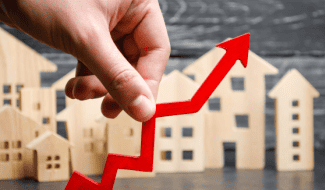Rent Prices Up In February After Six Months Of Declines

“This turnaround is in line with the rental market’s typical seasonal pattern, as we transition into the time of year when moving activity starts to gradually pick back up after bottoming out around the holidays,” the Apartment List Research Team writes in the report.
Rent prices ticked up 0.2 percent in February and currently the nationwide median rent stands at $1,377.
Rent inflation is receding
The Apartment List report says the rental market slowdown in gradually showing up in inflation numbers and has been visible in their reports over the past few months.
While the apartment rental market has cooled and apartments are generally less expensive than a year ago, the national median rent is still more than $200 per month higher than it was just three years ago which has contributed to inflation numbers.

The Wall Street Journal reports in an article that rent costs have been driving inflation numbers for months in official federal data. Prices in other areas may be responding to the Federal Reserve interest rate increases but rent costs are not.
“So, it’s been a bit of a mystery to economists why rent hasn’t followed suit. That’s especially because almost every data source, except the consumer price index kept by the Bureau of Labor Statistics, shows that those costs actually are cooling significantly — or even falling — since growth peaked early last year,” the Wall Street Journal reports.
Part of the problem with measuring rents and inflation the way the government tracks data is that a rental unit is only captured in the government surveys every six months, even if the rent changed during that period. The Bureau of Labor Statistics tracks rents for all tenants, not just those starting new leases — people staying put for a year or more might not see their costs change as rapidly.
But economists and others are not sure why the difference remains so pronounced month after month.
“We’re watching a big mountain of snow melt, and every 10 minutes, we look and there’s still a big pile of snow,” said Igor Popov, chief economist at Apartment List told the Washington Post. “We’re just watching it so carefully it doesn’t feel like we’re seeing much progress.”

Vacancy continues to rise
“On the supply side of the market, our national vacancy index continues trending up and stands today at 6.6 percent. And with this year expected to bring the most new apartment completions in decades, we expect that there will continue to be an abundance of vacant units on the market in the year ahead,” the report says.

What Lies Ahead?
“Historical seasonal patterns suggest that rents will continue trending up for the coming months, but we expect future rent increases to be moderated by a robust construction pipeline delivering new units throughout the year.
“With consumer sentiment about broader macroeconomic conditions beginning to improve, it’s possible that rental demand will also rebound in the year ahead, but likely not to an extent that would outweigh the impact of all the coming supply,” the report says.
Source: Rental Housing Journal
Free Rental Application
Get 20 Rental Forms for FREE, including a rental application.















 Accessibility
Accessibility